What started as a short-term response to a global crisis has now become a long-term shift in how we work, hire, and connect. But while many headlines still rely on older remote work stats from the early days of the pandemic, 2026 brings a much clearer picture of where things stand today.
This article brings together the latest remote work statistics and trends, based on the most recent research and reports.
Key remote work statistics
- In 2019, only 6.5% of U.S. private-sector workers worked primarily from home. This shows just how rare remote work was before the pandemic.
- Remote work jumped by more than 30 percentage points in some industries between 2019 and 2021.
- 81% of workers said remote work is the most important factor in a job, more than salary.
- 46% of U.S. remote-capable workers would likely quit if remote work was taken away.
- 99% of professionals say remote or hybrid work is better for their mental well-being.
- 61% of workers say they’re more productive working from home. Remote setups aren’t just comfortable — they can help people get more done.
- 84% of workers — especially younger ones — say they’re more productive in hybrid or remote environments.
- U.S. businesses lose $600 billion per year to workplace distractions.
- 80%+ of employers say remote options help attract and retain talent.
- 75% of employees say their current remote work tools need improvement. Technology gaps are still a big challenge for making remote work successful.
Guide to remote work statistics
Remote work statistics before and after COVID
Before the COVID-19 pandemic hit, remote work was pretty rare. Back in 2019, only about 6.5% of private-sector workers in the U.S. said they primarily worked from home, according to the U.S. Bureau of Labor Statistics. Most jobs still happened in offices, stores, or other physical workplaces. Working remotely was something mainly seen in a few tech jobs or freelance roles, not something you’d see every day across industries.
Then came the pandemic in early 2020, and everything changed. Offices shut down overnight, and companies had to figure out new ways to keep business going while keeping people safe. This massive shift sparked a huge rise in remote work — a change that happened faster than anyone expected.
By 2021, just a year into the pandemic, remote work had skyrocketed across nearly all major industries. In many cases, the share of people working from home increased by more than 30 percentage points compared to 2019. Some sectors made the transition faster and more fully than others, especially those where most of the work could be done online.
Even when restrictions eased in 2022 and offices reopened, remote work didn’t just vanish. Although some workers did return to physical offices, the number of remote workers remained much higher than before the pandemic in nearly every industry. In other words, the shift wasn’t just temporary — it permanently changed how and where people work.
Current share of workdays done from home
When you look at where people actually spend their workdays, remote work is still a big part of the picture, even if it is not at the crazy levels we saw in 2020.
In the United States, the WFH Research team (including Steven J. Davis, Nick Bloom, and José María Barrero) tracks the number of paid workdays performed from home versus on-site. Their data shows a clear story over time:
- In 2019, before COVID, only about 5–7% of paid workdays were done from home.
- During the 2020 lockdowns, that share shot up to roughly 60% of workdays.
- By 2025, things have settled into a stable pattern at around 25% of paid workdays worked from home.
So yes, remote work has dropped from the emergency peak, but it is still more than three times higher than before the pandemic. Working from home a couple of days a week is now a normal part of many office jobs, not a rare perk.
The same research group runs the Global Survey of Working Arrangements, which looks at work-from-home patterns across many countries. On average, workers now report about 1.3 days per week working from home. For college-educated employees, that also works out to roughly a quarter of their workdays happening at home instead of in the office.
The UK sits even higher. Using the same survey, analysis for the UK suggests that employees there work from home around 1.8 days per week on average, which puts the UK near the top of advanced economies when it comes to remote days.
If you put all of this together, the pattern is pretty simple:
- We are no longer in the “everyone at home all the time” phase of 2020.
- But we’re also nowhere near the old five-day office norm.
- For many knowledge workers, about one in four workdays now happens at home, and that share has stayed surprisingly steady over the last couple of years.
In other words, work from home has moved from “temporary fix” to a built-in part of the weekly rhythm in the U.S., the UK, and many other countries.
Global remote work adoption stats
Remote work has taken off around the world, but how it’s being adopted really depends on a few key factors, like how big the company is, where it’s located, and what employees actually want.
For starters, larger companies are much more likely to offer remote or hybrid work models than smaller ones. That’s because big organizations usually need to fill a wider variety of roles, many of which are highly specialized. To find the right people for those jobs, they often have to search outside of their local area, sometimes across the country or even internationally. Offering remote work helps them cast that wider net.
But geography plays just as big of a role. The preference for remote, hybrid, or in-office work changes quite a bit depending on the region. In North America, for example, leaders tend to prefer employees working from the office more than in other parts of the world. On the flip side, the Asia-Pacific (APAC) region shows the strongest lean toward fully remote work. Meanwhile, Western Europe is leading the way when it comes to hybrid setups, combining remote and in-office work in a way that fits with their long-standing focus on work-life balance.
Zoom’s findings show that while hybrid is the most common model globally, there’s no single approach that fits everyone. Instead, companies are adjusting their work strategies to fit their specific culture, industry, and team needs.
Employee preferences also play a big part in shaping these decisions. Gallup’s Hybrid Work Indicator shows that about 50% of full-time workers in the U.S. have jobs that could be done remotely. Most of these remote-capable employees are already working in either hybrid or fully remote setups, and they want to keep it that way. Speaking of…
Employee preferences for remote work
Over the past few years, employees have made it very clear: flexibility matters a lot, and it’s one of the top things they look for in a job.
In FlexJobs’ State of the Workforce Report, workers said that remote work is the most important factor in a job, even more important than salary. A huge 81% of people listed it as a top priority, compared to 77% who prioritized pay. And when asked about their ideal setup, 65% wanted fully remote jobs, and 34% preferred hybrid. Only a tiny group still chose fully in-office work.
Plus, according to a Robert Half survey, 61% of workers said they’re more likely to apply for a job if it offers remote or hybrid options. And 4 in 10 are actively looking for new jobs just so they can find permanent remote work.
Flexibility isn’t just a nice bonus anymore, but it means different things to different people. Younger workers might want in-person experiences to build connections and grow their careers. Meanwhile, older employees or caregivers might prioritize time at home to balance family or health. In fact, a Zoom survey showed that 58% of workers expect their work preferences to change over time, especially as life circumstances evolve.
For the time being, the remote work data show that taking away flexible options can push employees to leave. A Pew Research study found that 46% of U.S. workers with remote-capable jobs would likely quit if their remote options were taken away — 26% said they’d be very unlikely to stay. A WTW global survey found 53% of remote workers would start looking for a new job within a year if forced back into the office full-time.
It’s not just employees either. A Gartner survey showed that even 1 in 3 executives would consider quitting if forced to return to the office full-time. And nearly half of hybrid and remote workers (48%) said they’d take an 8% pay cut just to keep their remote setup. That’s how much flexibility matters.
How much is remote flexibility worth nowadays?
One of the clearest signs that remote and flexible work really matter is that people are willing to take less money to get it.
The Global Survey of Working Arrangements (G-SWA) project, led by researchers like Nick Bloom and Steven J. Davis, asks workers in many countries how much pay they would give up to work from home two or three days a week. On average, people say they would trade about 5% of their salary for that level of remote flexibility.
That might not sound huge at first, but think about what it means: if someone is earning $70,000 a year, they’re effectively saying, “I’d give up around $3,500 a year to keep my two or three work-from-home days.” That’s a pretty strong signal that fewer commutes, more control over the day, and a better work–life balance feel just as valuable as extra cash.
Owl Labs’ State of Hybrid Work 2025 survey of U.S. workers shows a similar, and in some ways stronger, pattern. In their data, employees say they would:
- Give up around 9% of their salary for flexible hours
- Give up about 8% for a four-day workweek
- Give up about 8% for a flexible working location
- And around 8% for more or unlimited vacation
Younger workers are especially willing to make these trade-offs. For them, being able to shift hours, skip some commuting, or organize work around childcare, school, or health isn’t just a perk. It’s part of what makes a job feel sustainable.
For employers, the message is pretty direct: Well-designed flexibility can act like a non-cash benefit. You may not always be able to outbid competitors on salary, but if your roles come with real, trusted flexibility in where and when people work, that can be worth several percentage points of pay in how attractive the job feels.
Remote work’s impact on mental health
Many people say remote work has had a positive effect on their mental and physical health. In FlexJobs’ Workforce Wellness Report, an overwhelming 99% of professionals agreed that remote or hybrid work was better for their mental well-being. Specifically, 56% said working fully remote helped their mental health the most, while 43% felt that a hybrid setup was best. Only 1% said full-time office work was ideal for their mental health.
Statistics on remote work productivity
One of the biggest questions companies have asked in recent years is, “Are people actually more productive when they work from home?” The answer, based on a growing pile of research, is yes — for the most part, remote and hybrid work setups are helping people get more done.
According to a study by the U.S. Bureau of Labor Statistics, industries that saw larger increases in remote work during the pandemic also experienced faster growth in productivity. Specifically, for every 1 percentage-point increase in remote work, there was about a 0.08 to 0.09 point rise in total factor productivity (TFP) — a measure that looks at how efficiently businesses use all their resources (labor, tools, equipment, etc.) to produce goods and services. Even when adjusting for pre-pandemic trends, the boost remained, though slightly lower at 0.05 points. In simple terms: more remote work = slightly more productivity, across many industries.
Another recent survey, conducted by Bospar in December 2024, backs this up. In that study:
- 61% of workers said they’re more productive working from home.
- 34% said they get the same amount of work done at home as they would in the office.
- Only 5% felt less productive. That’s a strong case for remote setups being a smart business move, especially when you add that 81.4% of respondents said remote work helped their work-life balance, and nearly 88% had proper home workspaces.
Employee views are also very clear: most people feel more productive outside of the traditional office. According to a Zoom report, 84% of workers, especially younger employees, said they perform better in hybrid or remote environments. This preference dips slightly with age, but the trend still holds across all age groups.
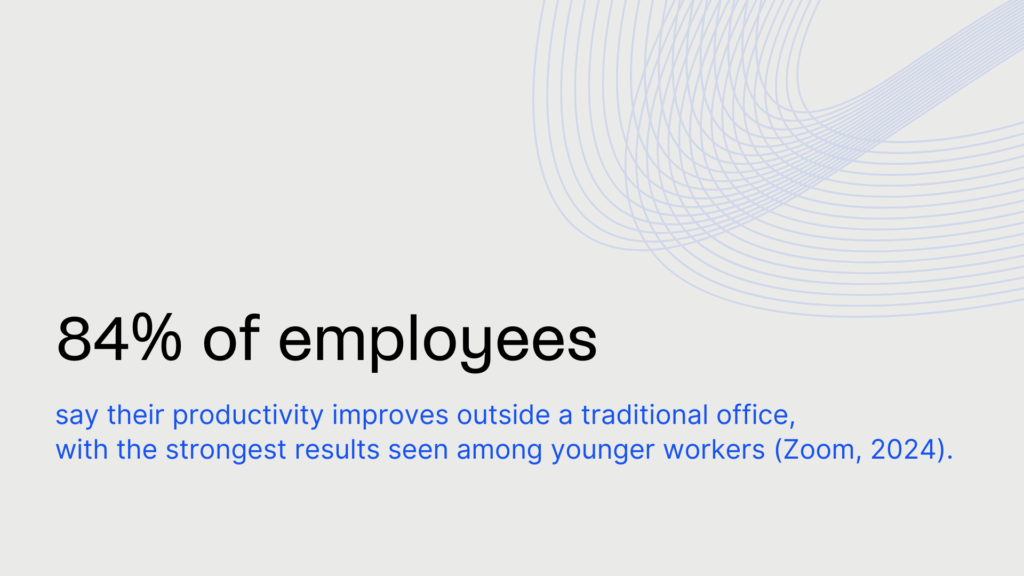
But, it’s also worth noting that how companies support remote and hybrid workers makes a big difference. Some employees worry that working from home might make them feel invisible, like they’re “out of sight, out of mind.” This is a real concern: fully remote workers are 1.3 times more likely to feel job insecurity than people who are always in the office.
Luckily, instead of focusing only on who’s in the office, companies are learning to check in regularly with remote team members, make sure everyone feels included, and provide equal opportunities for growth and recognition. And what’s in it for the employers, then?
Remote work benefits for companies
One of the biggest perks for companies is saving money. Research from Global Workplace Analytics shows that U.S. businesses lose $600 billion a year to workplace distractions. Remote setups help cut out many of those distractions, allowing people to focus more and get more done.
That same research also highlights other benefits of remote work, like:
- Healthier work environments with less risk of discrimination.
- More collaboration and empowerment, especially when employees have more control over how and when they work.
- Faster company growth, thanks to access to a wider talent pool and fewer limits based on office size or location.
According to a report from the U.S. Bureau of Labor Statistics, companies that embraced remote work were able to cut down on nonlabor costs — things like office space, utilities, and materials. Fewer people in the office means fewer desks, less electricity, smaller leases, and reduced maintenance — all of which add up to serious savings.
Stats about remote work challenges
At the same time, one of the biggest hurdles for remote workers is not having the same easy access to tools, equipment, or resources they’d usually find in the office. In fact, 31% of remote employees say that limited access to work resources is a top challenge. Whether it’s a printer, special software, or just a quiet space, working from home can make some tasks harder to complete.
And when it comes to virtual meetings, the flexible workspace tech doesn’t always cooperate. Common problems include:
- Poor audio or video quality
- Difficulty seeing or hearing remote participants
- Delayed meeting start times due to setup issues
As hybrid work becomes more common, meetings often involve both in-office and remote participants. 40% of office interactions now include remote workers, which can make coordination tricky. According to Zoom, 75% of employees think their current tools need improvement, and 72% believe their companies need new tools altogether to support remote working properly.
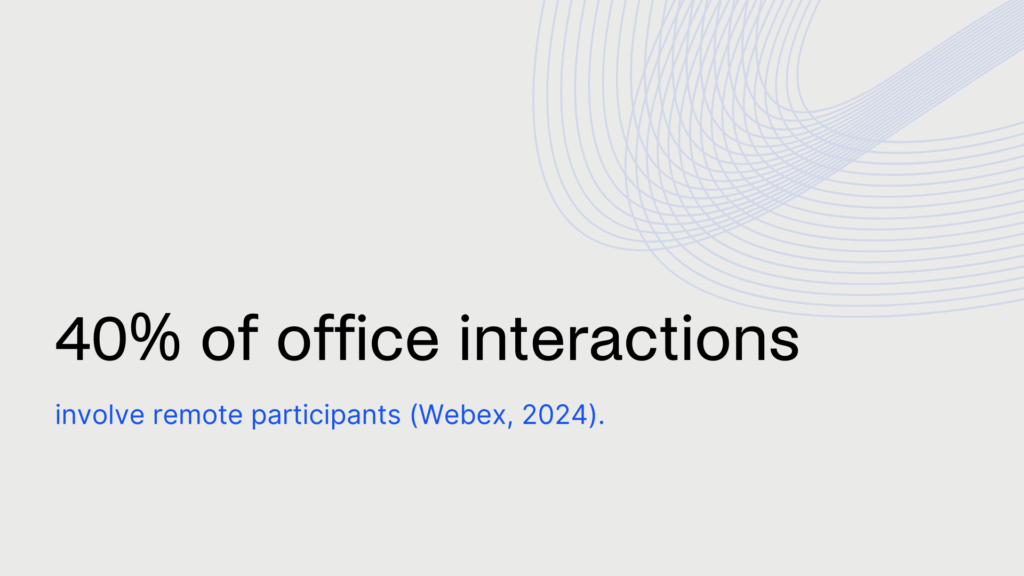
Another big challenge is feeling less connected to coworkers and company culture. This is especially true for hybrid workers who may not see their teammates regularly. According to BambooHR, over 40% of hybrid workers say they don’t feel as connected to colleagues who work remotely most of the time.
Here are some related issues workers face, according to FlexJobs:
- 28% feel disconnected from their company’s culture
- 24% say collaboration has decreased
- 21% struggle with coworker relationships
- 18% say cross-functional communication has dropped
- 17% find it harder to coordinate tasks and schedules
Working from home can blur the line between personal life and work, and that’s not always a good thing. According to FlexJobs’ Work Insights Survey, remote and hybrid workers say they struggle with:
- Overworking or working longer hours (28%)
- Not getting out enough (28%)
- Trouble working across time zones (19%)
- Technology problems (18%)
- Home distractions (17%)
Without the clear start and end of a commute, many people find it hard to log off. And when coworkers are spread across different time zones, it can make it tough to coordinate meetings or project deadlines, adding even more pressure.
The good news is that most companies are aware, and are stepping up to combat all these issues. Are you?
Retention and the risk of removing remote work
One clear message from recent research is this: taking away remote work is not a small policy tweak. It has a real impact on whether people stay or leave.
Pew Research Center looked at U.S. employees who have jobs that can be done from home and who currently work from home at least some of the time. In this group, 46% say they would be unlikely to stay in their job if they could no longer work from home, including 26% who say they’d be very unlikely to stay. Only 36% say they’d be likely to stay, and 17% sit in the middle.
Some groups feel even more strongly. Among fully remote workers, about 61% say they would be unlikely to stay if the option to work from home disappeared. Women are more likely than men to say they would leave (about 49% vs 43%), and workers under 50 are more likely than those 50 and older (about 50% vs 35%).
Owl Labs finds a similar pattern when they ask hybrid and remote workers what would happen if their flexible arrangement vanished. If they were no longer allowed to work remotely or in a hybrid way, about 40% say they would start looking for another job, 22% say they’d expect a raise to make up for the lost flexibility, 19% say they’d stay but be less happy, and around 5% say they would just quit.
So even before anyone actually resigns, you are likely to see more people quietly job hunting, pushing for higher pay, or staying but feeling frustrated if remote work is removed.
We also see the effect in real job moves. In the UK, CIPD’s 2025 research finds that about 3% of employees say they left a job in the last year mainly because it did not offer flexible working. That works out to roughly 1.1 million workers at the national level, with younger employees especially likely to have quit over a lack of flexibility.
None of this means everyone will walk out the day you add an extra office day. But it does show that strict “office-first” rules now come with a real churn risk, particularly for fully remote workers, women, and younger staff. In a tight labor market, that is not just an HR concern; it is a business risk.
50+ remote working statistics summarized
🌍 Global remote work statistics
- In 2019, only 6.5% of private-sector workers in the U.S. worked primarily from home (BLS).
- In some industries, remote work jumped by more than 30 percentage points between 2019 and 2021 (BLS).
- 50% of full-time U.S. workers have jobs that could be done remotely (Gallup).
👥 Employee preferences for remote work
- 81% of workers said remote work is the most important factor in a job (FlexJobs).
- 77% said salary was a top priority (FlexJobs).
- 65% prefer fully remote jobs (FlexJobs).
- 34% prefer hybrid jobs (FlexJobs).
- 61% of workers are more likely to apply for jobs with remote/hybrid options (Robert Half).
- 4 in 10 workers are looking for new jobs to find permanent remote work (Robert Half).
- 58% of employees expect their workplace preferences to change over time (Zoom).
- 46% of U.S. remote-capable workers would likely quit if remote work was taken away (Pew Research).
- 26% would be very unlikely to stay if remote work was removed (Pew Research).
- 53% of remote workers would look for a new job within a year if forced back to the office full-time (WTW).
- 1 in 3 executives would consider quitting if forced back to the office full-time (Gartner).
- 48% of hybrid and remote workers would take an 8% pay cut to keep their remote setup (Gartner).
🧠 Remote work mental health statistics
- 99% of professionals say remote or hybrid work is better for mental well-being (FlexJobs).
- 56% say fully remote work is best for their mental health (FlexJobs).
- 43% say hybrid is best (FlexJobs).
- 1% say full-time office work is best for mental health (FlexJobs).
📈 Remote work productivity statistics
- For every 1 percentage-point increase in remote work, total factor productivity (TFP) increased by 0.08–0.09 points. Adjusted for pre-pandemic trends, the increase in TFP was 0.05 points (BLS).
- 61% of workers say they’re more productive working from home (Bospar).
- 34% say they’re equally productive at home as in the office (Bospar).
- 5% say they’re less productive working from home (Bospar).
- 81.4% report better work-life balance while working remotely (Bospar).
- 87.5% have proper home workspaces (Bospar).
- 84% of workers — especially younger ones — say they’re more productive working remotely or hybrid (Zoom).
- Fully remote workers are 1.3 times more likely to feel job insecurity than full-time office workers (Zoom).
💼 Remote work benefits for companies
- U.S. businesses lose $600 billion per year to workplace distractions (Global Workplace Analytics).
- A 1-point increase in remote work is linked to a:
- 0.1 percentage-point drop in labor cost growth (BLS).
- 0.4 percentage-point drop in office building costs (BLS).
- 80%+ of employers say remote options help attract and retain talent (WTW).
⚠️ Remote work challenges
- 31% of remote workers struggle with limited access to work resources (equipment, tools).
- 28% feel disconnected from company culture (FlexJobs).
- 24% say team collaboration has decreased (FlexJobs).
- 21% say coworker relationships have weakened (FlexJobs).
- 18% report reduced cross-functional communication (FlexJobs).
- 17% struggle to coordinate schedules and tasks (FlexJobs).
- 40% of office interactions now involve remote participants (Webex).
- 75% of employees say their remote work tools need improvement (Zoom).
- 72% think their companies need new tools for remote work (Zoom).
- Over 40% of hybrid workers feel less connected to teammates who are mostly remote (BambooHR).
- FlexJobs Work Insights Survey found these additional challenges:
- 28% overwork or work longer hours.
- 28% say they don’t get out enough.
- 19% struggle working across time zones.
- 18% face technology issues.
- 17% are distracted by non-work things at home.
- 16% of remote workers worry about being “invisible” to their manager (FlexJobs).
- According to Owl Labs, if hybrid or remote work were no longer allowed:
- About 40% say they would start looking for another job.
- 22% say they would expect a pay raise to make up for the lost flexibility.
- 19% say they would stay but be less happy.
- Around 5% say they would quit.
- On average, workers say they would give up about 5% of their salary to work from home two to three days per week (G-SWA).
Sources
- Zoom, Navigating the Future of Work: Global Perspectives on Hybrid Models and Technology
- Gallup, Hybrid Work Indicator
- U.S. Bureau of Labor Statistics, The rise in remote work since the pandemic and its impact on productivity
- Owl Labs, 8th Annual State of Hybrid Work
- Webex, The State of Hybrid Work, Global 2024
- The ADP Research Institute, People at Work 2024: A Global Workforce View
- WTW, Flexible Work Models Pulse Survey
- Robert Half, Demand for Skilled Talent Report
- BambooHR, Return to Office Data Story
- Gartner, The Data Is In: Return-to-Office Mandates Aren’t Worth the Talent Risks
- Pew Research Center, Survey of U.S. workers
- FlexJobs, State of the Workforce Report
- Bospar’s 10th anniversary research confirms remote work drives superior business outcomes
- Archie, Hybrid Work Statistics in 2025: Productivity & Preferences
- Archie, Return-To-Office Statistics, Research & Trends
- WFH Research, Global Survey of Working Arrangements (G-SWA)
- Pew Research Center, Many remote workers say they’d be likely to leave their job if they could no longer work from home
- Owl Labs, State of Hybrid Work 2025
- CIPD, Flexible and hybrid working practices in 2025

Berenika Teter
Archie's Content Manager, fueled by filter coffee and a love for remote work. When she’s not writing about coworking spaces and hybrid workplaces, you can probably find her exploring one.

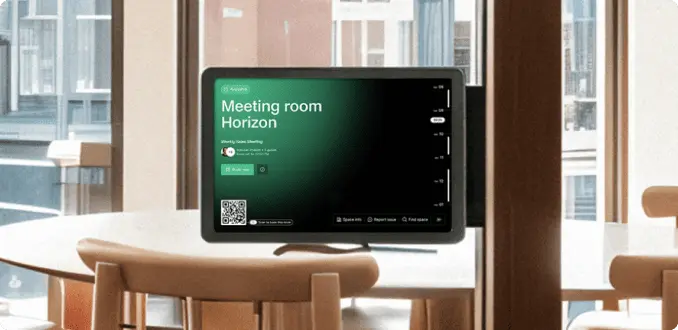



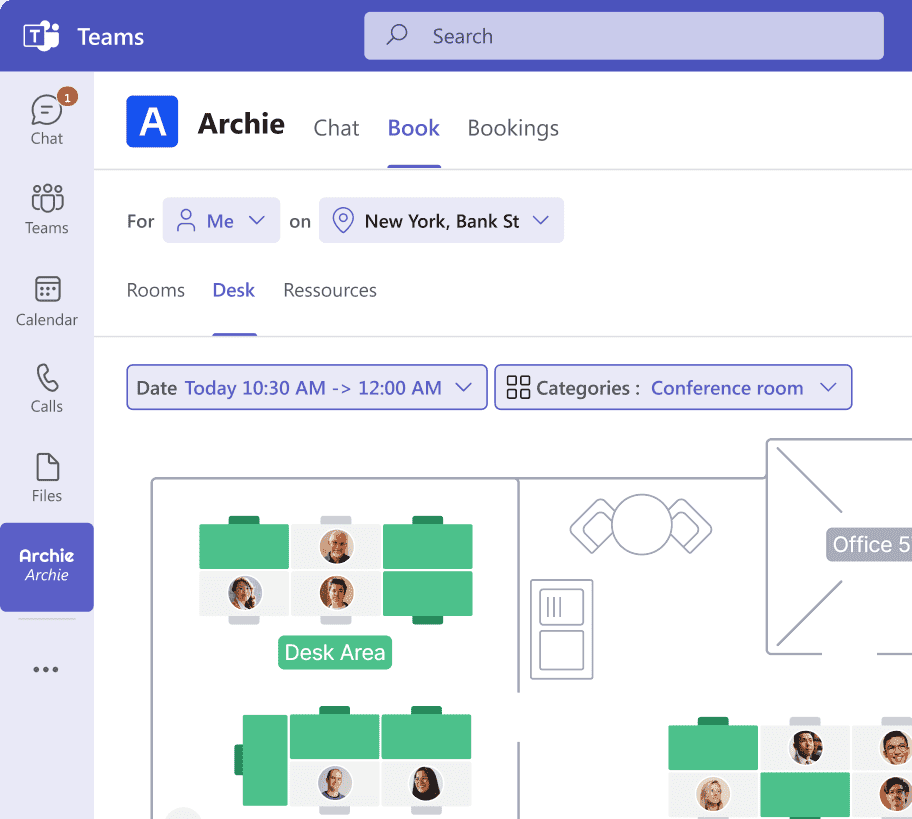
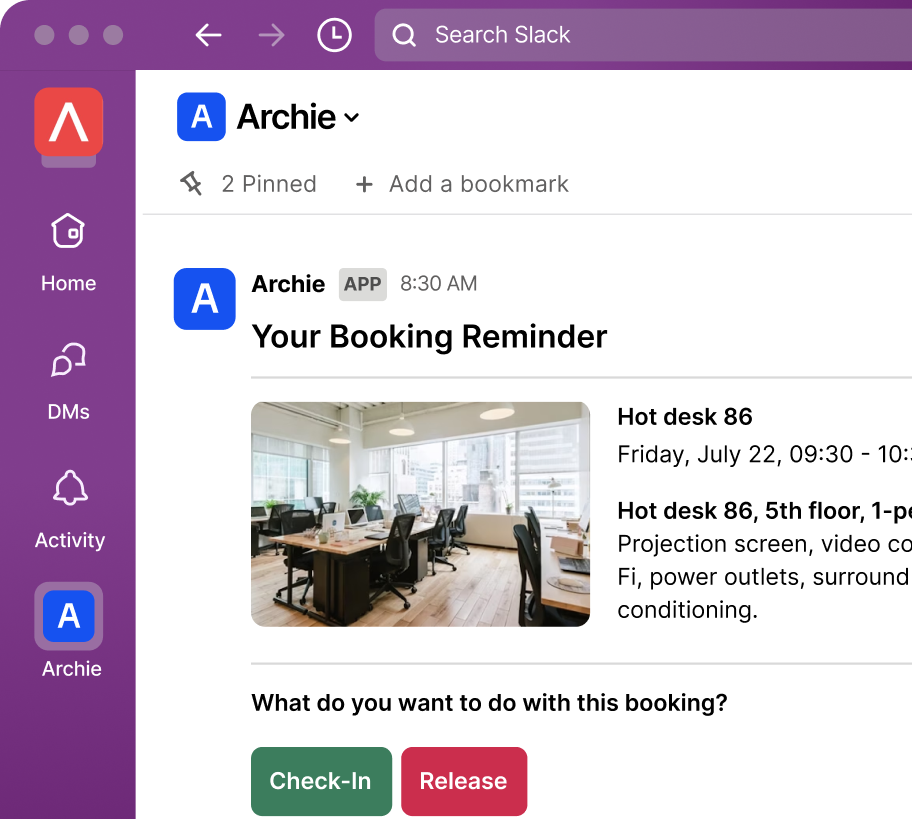



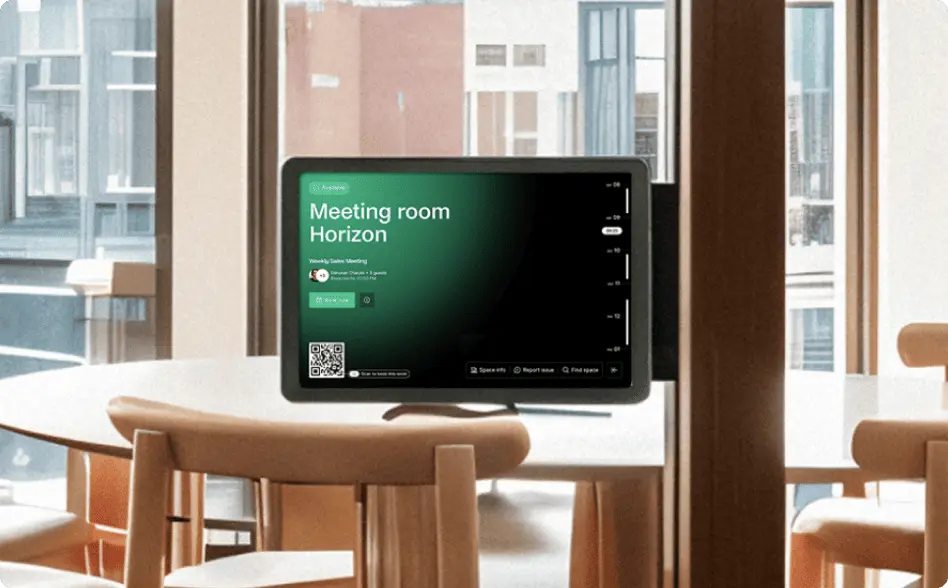
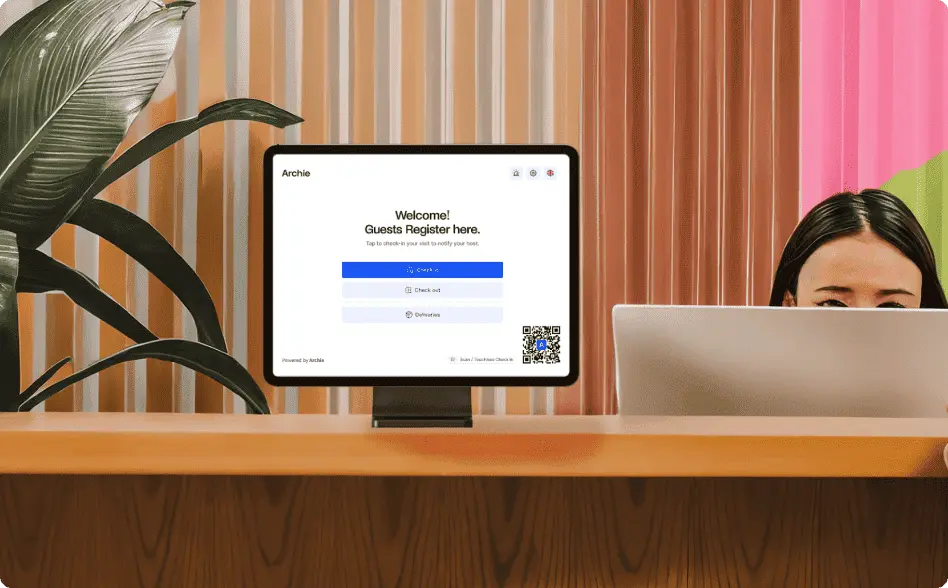



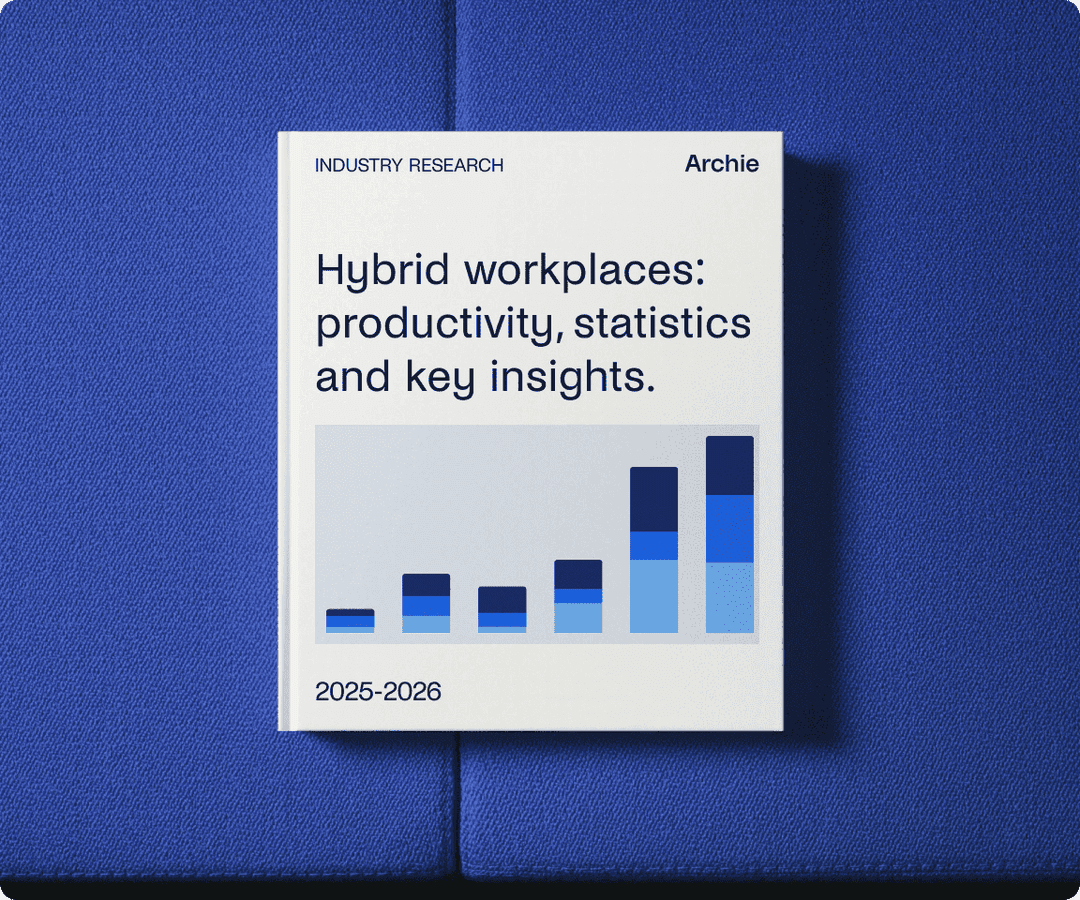

![The Latest Remote Work Statistics and Trends [2026] Smiling woman sitting on a couch, video chatting on her laptop in a cozy, wood-paneled room.](https://archieapp.co/blog/wp-content/uploads/2025/04/Latest-remote-work-statistics-cover-image.jpg)
![The Latest Coworking Statistics & Industry Trends [2026] A cozy coworking space with wooden walls, warm lighting, and a large map of South America.](https://archieapp.co/blog/wp-content/uploads/2025/08/Latest-coworking-statistics-cover-image-400x400.jpg)
![RTO: Return-To-Office Statistics, Research & Trends [2026] Modern meeting room with large windows, a wooden conference table, pink chairs, and industrial-style ceiling lighting.](https://archieapp.co/blog/wp-content/uploads/2025/04/RTO-statistics-cover-image-400x400.png)

